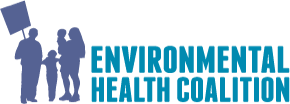After years of advocacy, environmental justice activists celebrate San Diego’s Climate Action Plan’s ambitious clean air goals while calling for funding that prioritizes the City’s most polluted and under-resourced communities.
SAN DIEGO, CA, August 3, 2022 – During Wednesday’s City Council meeting, in a 8 to 0 vote, the San Diego City Council approved the updated 2022 Climate Action Plan (CAP). For the first time, the CAP has a clean air section that commits the City to reduce levels of diesel particulate matter (PM) by 80% from 2016 levels by 2030 with priority in most impacted communities as identified by the draft CalEnvironScreen (CES) 4.0. While celebrating the CAP’s strong clean air goals, community activists continue to push for a commitment to prioritize funding for the most under-resourced and over-polluted communities in San Diego.
“The CAP’s clean air goals are a major win for environmental justice communities because air pollution has traditionally been excluded from climate change solutions – including the City’s previous 2015 Climate Action Plan,” said Diane Takvorian, Executive Director at Environmental Health Coalition (EHC). “However, these goals will be meaningless if the CAP doesn’t prioritize funding solutions for residents breathing the most dangerous air in the City, who are also the most vulnerable to climate change.”
The CAP determines where and how the City will spend millions of dollars to combat the climate crisis. Activists from Barrio Logan, Logan Heights, and City Heights attended Wednesday’s City Council meeting demanding the CAP include stronger clean air goals and prioritize 90% of project funding in communities like theirs that need it the most.
“The air quality is impacting my health and my livelihood. I’ve suffered from chronic rhinitis since I was an infant,” said Emily Villagrana, a lifelong Logan resident. “All of us want a clean San Diego, but it is more urgent for those that are suffering the health effects. Please don’t ignore us.”
Communities like Villagrana’s breathe some of the most diesel-polluted air in the state, which causes cancer, asthma, and other chronic diseases. Diesel pollution also accelerates climate change. According to the U.S. EPA and California Air Resources Board, black carbon is up to 450 – 1,500 times more powerful at warming the climate than carbon dioxide and other well-known climate-warming gases.
In addition to breathing lung-damaging air, communities like Barrio Logan also have a severe shortage of tree coverage, cool zones, parks, and other resources that mitigate extreme heat. This combination makes them more vulnerable to the impacts of climate change – like heat waves, droughts, and smoke from wildfires.
“If you think about the City as a street of houses, and each neighborhood is a house, then the communities of Logan, City Heights, and San Ysidro are houses on fire,” said Kyle Heiskala, EHC’s Climate Justice Policy Advocate. “There is no equity without funding. It is like measuring how hot it is in the burning house without sending any resources to put out the flames. The CAP implementation must commit to funding 90% of environmental justice community projects first.”
The City Council approved the Climate Action Plan and an implementation plan with an additional council policy to inform the prioritization of climate actions is expected to come back to the City Council for approval in February of 2023.
MEDIA CONTACT:
Angelica Estrada
Communications Director, Environmental Health Coalition
562-708-3093
Angelicae@environmentalhealth.org
###ABOUT ENVIRONMENTAL HEALTH COALITION
Founded in 1980, Environmental Health Coalition (EHC) builds grassroots campaigns to confront the unjust consequences of toxic pollution, discriminatory land use, and climate change. Visit www.environmentalhealth.org to learn more.

